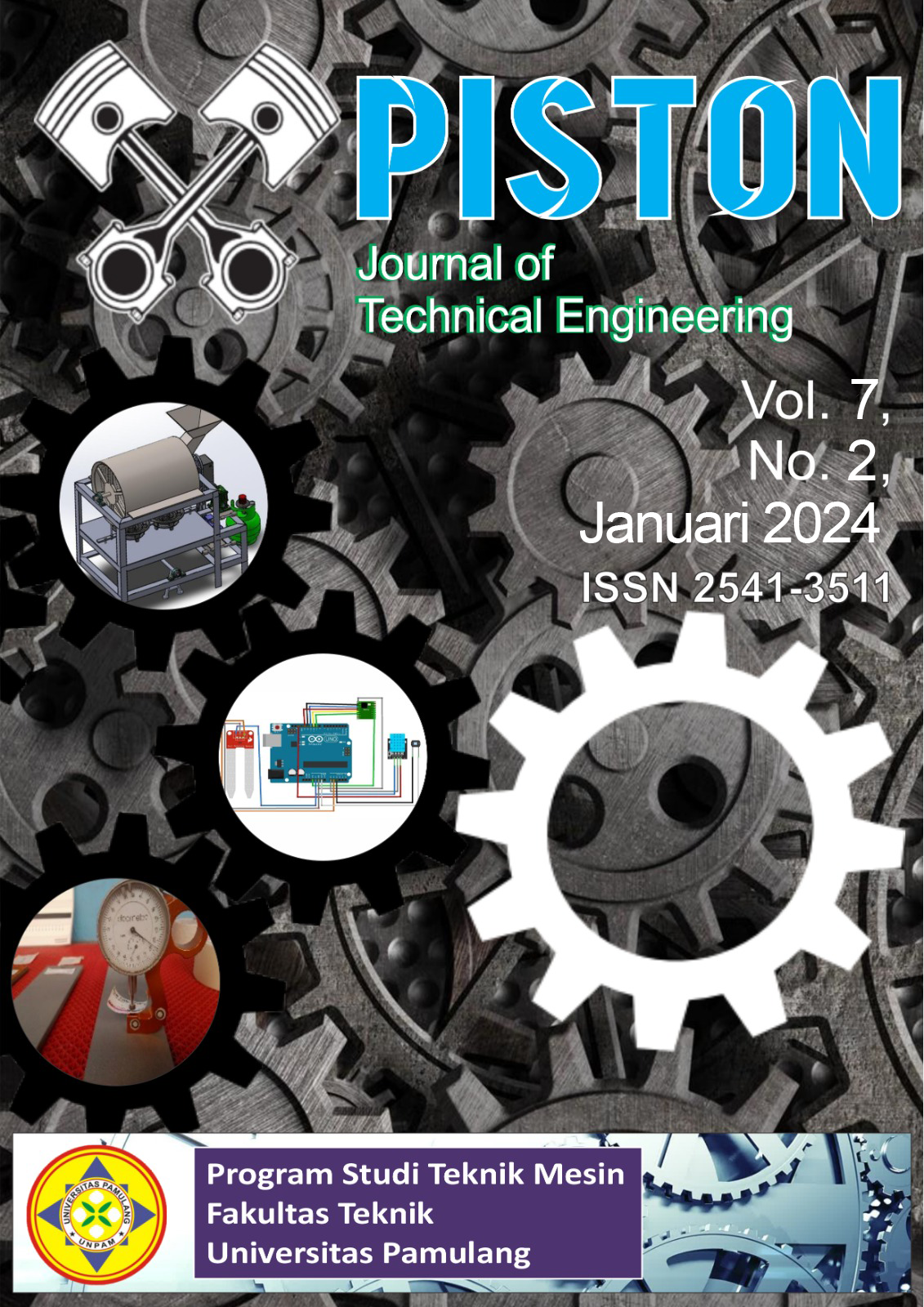Mechanical and Thermal Properties Analysis on Bitumen Mixture with Additives: HDPE, PP and Lignin
DOI:
https://doi.org/10.32493/pjte.v7i2.35464Keywords:
Bitumen modification, Plastic waste recycling, Hot melt mixing, Asphalt performance, BiopolymersAbstract
This study focuses on enhancing the performance and sustainability of asphalt materials in road construction by recycling High-Density Polyethylene (HDPE). Polypropylene (PP) and lignin as additives in bitumen. The Hot Melt Mixing method is employed to investigate the impact of different concentrations of HDPE, PP, and lignin on bitumen properties. Key properties such as ductility, penetration, softening point, and thermal behavior are analyzed, providing valuable insights into the potential of these additives to enhance bitumen performance. The findings demonstrate that higher concentrations of HDPE and PP result in reduced penetration depth, indicating increased hardness. The addition of lignin enhances penetration depth, contributing to the flexibility and performance of the bitumen mixture. Moreover, thermal analysis offers valuable information about the thermal behavior and stability of the bitumen-plastic-lignin blends, shedding light on their compatibility and interactions. This research contributes to the ongoing efforts in road construction and pavement engineering by exploring sustainable solutions that not only address plastic waste challenges but also improve the performance and durability of bituminous materials, making it a crucial step towards environmentally responsible and long-lasting asphalt pavements.References
M.-C. Liao, J.-S. Chen, and K.-W. Tsou, “Fatigue Characteristics of Bitumen-Filler Mastics and Asphalt Mixtures,†Journal of Materials in Civil Engineering, vol. 24, no. 7, pp. 916–923, Jul. 2012, doi: 10.1061/(ASCE)MT.1943-5533.0000450.
S. B. Borrelle et al., “Predicted growth in plastic waste exceeds efforts to mitigate plastic pollution,†Science (1979), vol. 369, no. 6510, pp. 1515–1518, Sep. 2020, doi: 10.1126/science.aba3656.
S. Wu and L. Montalvo, “Repurposing waste plastics into cleaner asphalt pavement materials: A critical literature review,†J Clean Prod, vol. 280, p. 124355, Jan. 2021, doi: 10.1016/j.jclepro.2020.124355.
D. A. Setiaji, M. Chalid, T. Abuzairi, M. Efroza, and A. F. Nugraha, “Effect of Cold Plasma Treatment on Physical Properties of Multilayer Plastics for Polymer Asphalt Applications,†Piston: Journal of Technical Engineering, vol. 6, no. 1, p. 1, Jul. 2022, doi: 10.32493/pjte.v6i1.20771.
A. N. Roziafanto, F. H. Alfarisi, T. H. Ramadhan, and M. Chalid, “Preliminary Study of Modified Lignin Compatibility in Polypropyleneâ€Modified Bitumen,†Macromol Symp, vol. 391, no. 1, Jun. 2020, doi: 10.1002/masy.201900158.
E. Yuanita, B. E. Hendrasetyawan, D. F. Firdaus, and M. Chalid, “Improvement of polypropylene (PP)-modified bitumen through lignin addition,†IOP Conf Ser Mater Sci Eng, vol. 223, p. 012028, Jul. 2017, doi: 10.1088/1757-899X/223/1/012028.
M. S. Dwijaya, D. A. Setiaji, J. H. Mustafa, and M. Chalid, “Lignin Effect to Synthesis of the Hybrid Polyurethane,†IOP Conf Ser Mater Sci Eng, vol. 740, no. 1, p. 012059, Jan. 2020, doi: 10.1088/1757-899X/740/1/012059.
Q. E. A. Alaye, X. Ling, Z. Dong, and G. Bambou, “Evaluation of Mixture Performance Recycled Asphalt Pavement Materials as Base Layer with or without Rejuvenator into the Asphalt,†Journal of Wuhan University of Technology-Mater. Sci. Ed., vol. 35, no. 3, pp. 579–597, Jun. 2020, doi: 10.1007/s11595-020-2295-4.
L. O. Oyekunle, “Certain Relationships between Chemical Composition and Properties of Petroleum Asphalts from Different Origin,†Oil & Gas Science and Technology - Revue de l’IFP, vol. 61, no. 3, pp. 433–441, May 2006, doi: 10.2516/ogst:2006043a.
C. Oliviero Rossi, A. Spadafora, B. Teltayev, G. Izmailova, Y. Amerbayev, and V. Bortolotti, “Polymer modified bitumen: Rheological properties and structural characterization,†Colloids Surf A Physicochem Eng Asp, vol. 480, pp. 390–397, Sep. 2015, doi: 10.1016/j.colsurfa.2015.02.048.
B. Radovskiy and B. Teltayev, Viscoelastic Properties of Asphalts Based on Penetration and Softening Point, vol. 2. Cham: Springer International Publishing, 2018. doi: 10.1007/978-3-319-67214-4.
N. Z. Habib, I. Kamaruddin, M. Napiah, and M. T. Isa, “Rheological properties of polyethylene and polypropylene modified bitumen,†International Journal Civil and Environmental Engineering, vol. 3, no. 2, pp. 96–100, 2011.
S. E. Salih, A. F. Hamood, and A. H. Alsabih, “Comparison of the Characteristics of LDPE : PP and HDPE : PP Polymer Blends,†Mod Appl Sci, vol. 7, no. 3, Feb. 2013, doi: 10.5539/mas.v7n3p33.
Z. J. Fan, M. C. Williams, and P. Choi, “A molecular dynamics study of the effects of branching characteristics of LDPE on its miscibility with HDPE,†Polymer (Guildf), vol. 43, no. 4, pp. 1497–1502, Feb. 2002, doi: 10.1016/S0032-3861(01)00730-3.
J. Yu, M. Vaidya, G. Su, S. Adhikari, E. Korolev, and S. Shekhovtsova, “Experimental study of soda lignin powder as an asphalt modifier for a sustainable pavement material,†Constr Build Mater, vol. 298, p. 123884, Sep. 2021, doi: 10.1016/j.conbuildmat.2021.123884.
E. A. Septimorien, L. M. D. Friskila, B. Natasya, and M. Chalid, “Ductility improvement of high density polyethylene (HDPE)-modified bitumen through adding modified lignin,†IOP Conf Ser Mater Sci Eng, vol. 541, no. 1, p. 012035, Jun. 2019, doi: 10.1088/1757-899X/541/1/012035.
J. D. Menczel and R. B. Prime, Eds., Thermal Analysis of Polymers. Wiley, 2009. doi: 10.1002/9780470423837.
C. S. A. L. Gaol, B. Priyono, M. Chalid, and A. F. Nugraha, “THE EFFECT OF MULTILAYER PLASTIC WASTE ADDITION TO POLYMER MODIFIED BITUMEN CHARACTERISTICS,†OISAA Journal of Indonesia Emas, vol. 6, no. 1, pp. 57–64, Jan. 2023, doi: 10.52162/jie.2023.006.01.7.
H. Soenen et al., “Differential Scanning Calorimetry Applied to Bitumen: Results of the RILEM NBM TG1 Round Robin Test,†2013, pp. 311–323. doi: 10.1007/978-94-007-6878-9_23.
A. F. Nugraha, A. J. Naindraputra, C. S. A. L. Gaol, I. Ismojo, and M. Chalid, “Polypropylene-based Multilayer Plastic Waste Utilization on Bitumen Modification for Hot-Mixed Asphalt Application: Preliminary Study,†Journal of Applied Science, Engineering, Technology, and Education, vol. 4, no. 2, pp. 157–166, Nov. 2022, doi: 10.35877/454RI.asci1119.









